Temple of Ancient Idols and Mummies Discovered in Peru
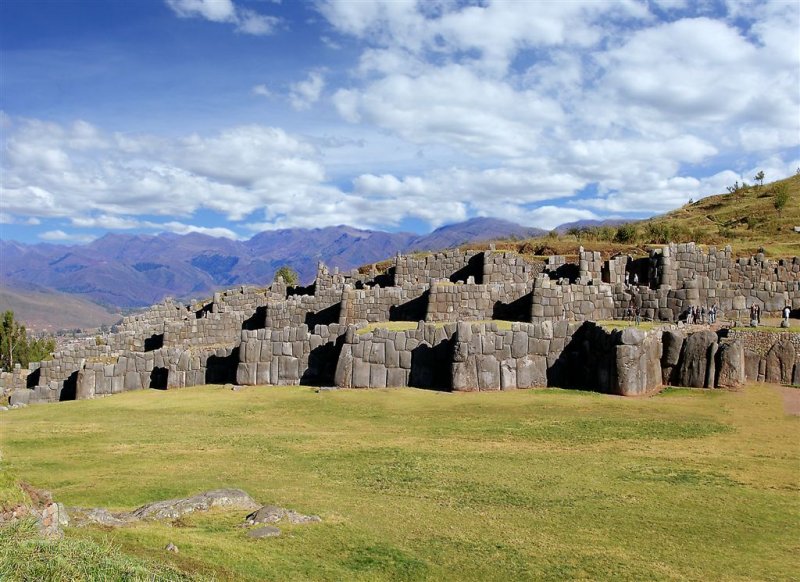
(Above: The Inca ruins of Sacsayhuaman (also Saqsaywaman) lie just above the city of Cuzco, Peru, at an elevation of nearly 12,000 feet)
Ancient Temple Discovered Among Inca Ruins
National Geographic News
March 31, 2008
A temple thought to have once housed idols and mummies has been unearthed near an ancient Inca site in Cusco, Peru…
(more…)
Saqsaywaman: The Last Days of the Incas’ Peru Tour #11
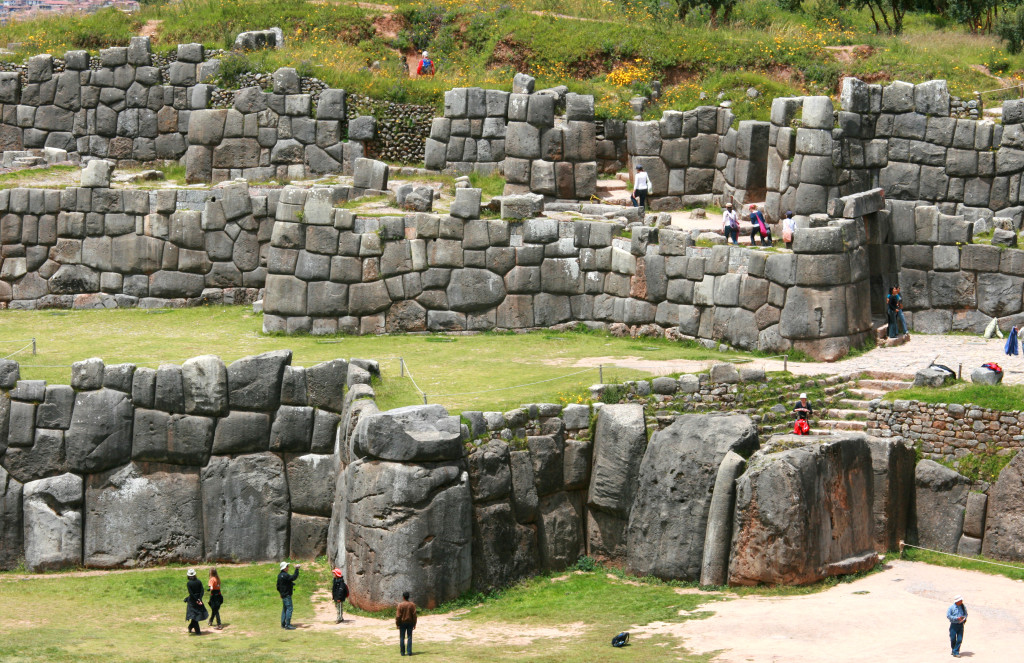
The Inca Ruins of Saqsaywaman
Cusco (3-4 Days)
Visiting the Inca Ruins of Saqsaywaman
When the Inca emperor Manco Inca rose up against Francisco Pizarro and his men in 1536, the emperor at first escaped from the city, then returned with several hundred thousand Inca warriors who trapped the 190 Spaniards within two small buildings on Cusco’s main square. Francisco Pizarro was in Lima at the time leaving three of his brothers—Hernando, Juan, and Gonzalo—in charge of the city. Thoroughly unnerved by the massive size and scale of the rebellion, the three brothers decided that the Spaniards’ only chance was to break out of the city and to somehow capture the massive Inca ceremonial center of Saqsaywaman, now being used as a fortress, that loomed above. Saqsaywaman, it turned out, was the key to capturing the Inca’s capital.
Quoting from Chapter 9 of The Last Days of the Incas:
“Conferring with Manco’s cousin Pasac, who had sided with the Spaniards, Juan and Hernando [Pizarro] decided that the only way to attempt storming the fortress of Saqsaywaman was to first somehow break through the legions of warriors to the north of the city, gaining the road that led to Jauja, and then, if successful, to wheel about and ride east around the hills until they reached the grassy plain fronting the fortress. Once there, the Spaniards would have to somehow launch a frontal assault against the Incas’ colossal walls. To many of those who listened to the plan, the mission seemed suicidal. Still, unless they were somehow able to seize the initiative, all realized that they were doomed to remain in the city and to gradually be worn down by attrition. With the grace of God, thought some, the desperate plan just might work…
(more…)
The Last Days of the Incas’ Peru Tour #10 (Cusco)
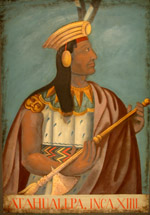
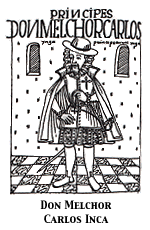
Cusco (3-4 Days)
Visiting The Cora Cora
To the north and uphill from the Plaza de Armas runs Suecia Street. At its base and reaching the plaza once stood the Cora Cora, which was the palace of Sinchi Roca, an early Inca king. During Manco Inca’s uprising, his warriors seized the area around Cora Cora, and from it rained down sling stones and arrows against the conquistadors, who were holed up next to what is now the Cathedral. Although the palace is not visible from the street, if you go into any of the courtyards or restaurants along Calle Suecia, you can still see one of the massive stone walls that made up the palace (have lunch in the Gaucho Grill, for example, whose massive rear wall is actually a 500-year-old palace wall).
Visiting the Church of Paullu Inca, Manco Inca’s Brother
If you continue up Suecia Street from the Cora Cora, then turn right and head up a parallel street further up the hill, called Resbalosa, you’ll come to San Cristóbal Church, which sits on a promontory that overlooks Cusco. The church was built by Paullu Inca, Atahualpa’s youngest brother and the brother of Manco Inca, the great Inca rebel emperor who fought a protracted war against the Spanish and nearly won…
(more…)
The Last Days of the Incas’ Peru Tour #9 (Cusco)
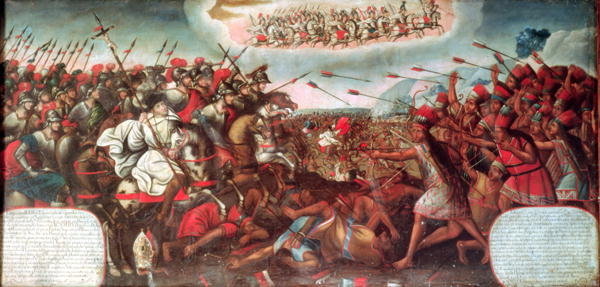
The Last Days Of The Incas Battle Scene
Cusco (3-4 Days)
Visiting La Merced Monastery and Church
(Burial site of Diego de Almagro Sr, Diego de Almagro Jr, and Gonzalo Pizarro. Repository of the painting (above) that adorns the cover of The Last Days of the Incas)
Just a block to the southwest of the Plaza de Armas (which makes three major churches in a three-block radius!) lies La Merced Monastery and Church, begun in 1534 and rebuilt in the late 17th century. The monastery (to the left of the church) is one of the little-known jewels of Cusco and is beautifully designed around a central garden and courtyard. The arcades around the garden are surprisingly hung with a large number of “Cusco-school”-style paintings of very high quality. The first painting on the left, in fact, as you enter the monastery, is the same painting that adorns the (U.S. and Canadian version) cover of The Last Days of the Incas. It actually depicts armored Spaniards on horseback fighting the fierce Araucanian Indians in central Chile, who resisted Spanish attempts to conquer them for centuries. On one of the horses rides a white-robed Mercedarian friar carrying a lance–one end of which bears a metal crucifix. Above him, the Spanish patron Saint Santiago, whom the Spaniards often invoked during their pitched battles against various natives in South America, is performing a miracle—turning the Araucanians’ arrows back upon themselves. On the far side of the cloister you’ll find a small art museum. Within it (and outside on the cloister’s walls) is the best collection of Cusco-school paintings in the world…
(more…)
The Last Days of the Incas’ Peru Tour #8 (Cusco)
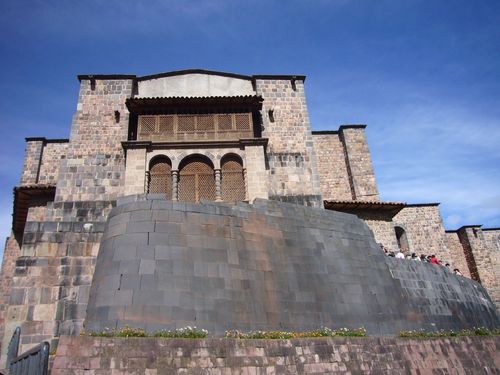
Cusco (3-4 Days)
Visiting the Qoricancha, or Inca Temple of the Sun
Two long blocks southeast of Cusco’s Plaza de Armas stands the church of Santo Domingo and below it, the Inca’s most sacred temple, the Qoricancha, or temple of the sun. When the first three Spaniards Pizarro had sent to Cusco arrived, they found the Incas’ sun temple gleaming literally like gold. With Pizarro still holding the Inca emperor Atahualpa hostage in northern Peru, the Inca general in charge of the city, General Quisquis, found himself forced to comply with Atahualpa’s orders to help the three Spaniards loot gold and silver from the capital.
Quoting from Chapter 5 of The Last Days of the Incas:
“What had really caught the trio’s attention, however, from the moment they had looked down upon the capital after crossing the final crest of hills, were certain buildings that seemed to burn as brightly as the sun, as if the buildings themselves had been dipped into a golden fire. After some investigation, they discovered that, sure enough, “These buildings were sheathed on the side where the sun rises with large plates of gold…They said there was so much gold in all the buildings of the city that it was a marvelous thing…[and that] they would have brought much more of it if this would not have detained them longer, because they were alone and over 250 leagues from the other Christians….”
(more…)
The Last Days of the Incas’ Peru Tour #7 (Cusco)
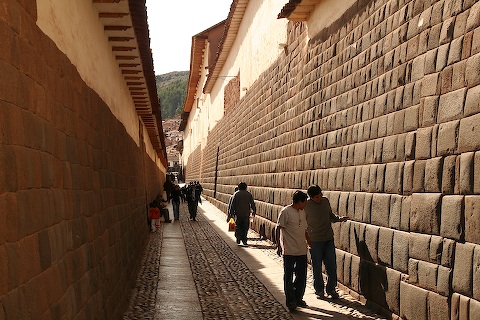
Cusco (3-4 Days)
Visiting the Location where Diego de Almagro Captured Hernando and Gonazalo Pizarro During Almagro’s Seizure of Cusco in 1537
(Above: Loreto Street in Cusco; on the left is the wall of the Inca palace known as the Amaru Cancha.On the right is the outside wall of the Acclawasi, or the temple of the “Chosen Women”).
It was in 1537, shortly after Manco Inca lifted his siege of Cusco, on the southeastern portion of Cusco’s Plaza de Armas, where Hernando Pizarro, his brother Gonzalo, and about twenty followers were seized by Diego de Almagro—the first in a chain of incidents that would lead to a deadly civil war. The Pizarros had holed up in Huayna Capac’s former palace of Amaru Cancha in 1537, just as Diego de Almagro, Pizarro’s former partner, had returned from Chile. Much of the site is now occupied by the Jesuit church, La Compañía; however, some of the wall of the Amaru Cancha can still be seen on the eastern side of Loreto Street, that runs from the southeastern part of the square (Amaru Cancha, in the Incas’ language, Quechua, means “Snake House” or “House of the Serpents”; the snake among the Incas was a symbol of knowledge and learning, a stone with a carved snake can still be seen along Calle Loreto, on one of the Amaru Cancha’s walls)…
(more…)
The Last Days of the Incas’ Peru Tour #6 (Cusco)
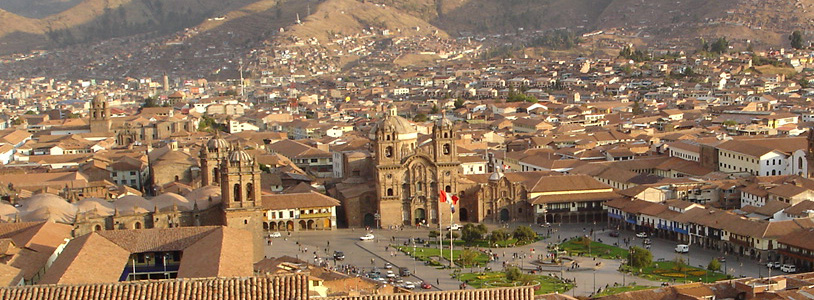
Cusco (3-4 Days)
Visiting Cusco’s Plaza de Armas, or Main Square
On November 15, 1533, Francisco Pizarro and his men arrived in the city of Cusco, after skirmishing with an Inca army to the north of the city, but which during the night had withdrawn. Pizarro and his men thus walked unopposed into the city, and bivouacked on the main square. The square, twice the size of the present one now, was lined with the palaces of former Inca Emperors and these were quickly seized by Pizarro and his top captains as residences.
The original Inca square was divided in the middle by the Saphi River, which now runs beneath the buildings on the southwest side of the square (the portals of which are called Portal de Comercio and Portal de Confituría). The rest of the Inca square was partially comprised by what is now known as the Plaza Recogio, which lies a block to the west.
Locations of the Conquistadors’ and Inca Emperors’ Palaces
On the northwestern corner of the Plaza de Armas once stood the Casana, presumably one of the palaces of the last Inca emperor to rule over an undivided empire: Huayna Capac, the father of the two warring brothers, Atahualpa and Huascar, and also of Manco Inca and Paullu Inca. Francisco Pizarro quickly selected this palace to reside in and a corner of the palace still remains, part of what is currently the Pachacutec Bar & Grill…
(more…)
The Last Days of the Incas’ Peru Tour #5 (Cusco)
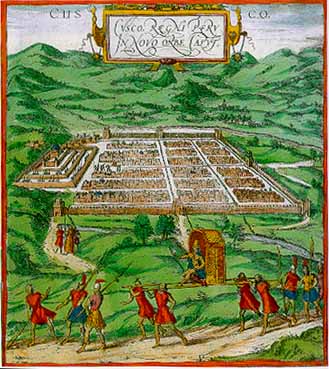
Cusco (3-4 days)
The Arrival of the first Spaniards in Cusco
In 1533, while Francisco Pizarro and his men held the Inca Emperor Atahualpa hostage for a ransom of gold in the north of Peru in Cajamarca, Pizarro sent three of his men—a Basque notary and two former sailors—600 miles southwards to Cusco, a city the Spaniards had only heard about but which they had been assured held vast quantities of gold. Pizarrro’s instructions to his men were to “take possession” of the city for the Spanish crown, and to help expedite the collection of gold and silver for Atahualpa’s ransom. The two sailors and the notary were thus the first Europeans to be carried in royal Inca litters along the spine of the Andes and were also the first Europeans as well to view and enter the Incas’ capital.
Quoting from chapter 5 of The Last Days of the Incas, this is some of what they saw:
“The small procession soon headed south from Cajamarca, climbing the flanks of fantastic mountains, cutting past pale, blue-green glaciers, crossing through Inca cities and villages set besides rivers that sparkled in the sun, then traversing giant gorges on hanging Inca bridges while witnessing vast flocks of llamas and alpacas that seemed to extend for as far as the eye could see. Strangers in a strange land, these were the first Europeans to witness an untouched Andean world never before seen, one with a thriving native civilization in all of its color and scarcely understood complexity. Everything was new—plants, animals, people, villages, mountains, herds, languages, and cities. A trio of Marco Polos adrift in the New World, they were similarly off to seek riches in a distant and fabled city….
(more…)









